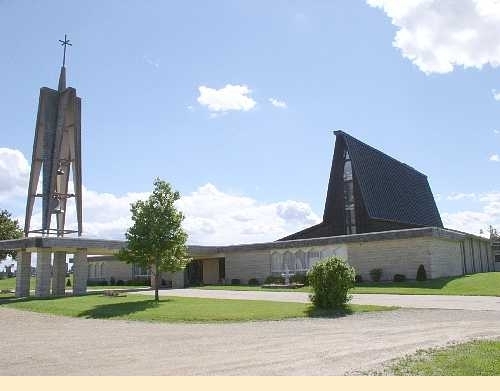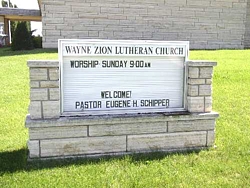
On June 1, 1872, sixteen families of the Lutheran faith bonded together
to organize Zion Evangelical Lutheran Church in Wayne Township, Jones
County, Iowa. The first house of worship, a single 28' x 48' structure
was built upon land purchased from Willm Helgens and Albert Siemers and
dedicated in December 1873. Two-thirds of the structure was used as a
church and the remainder of the building was used as a pastor's home.
This original church was enlarged and rededicated on July 19, 1908, and
the current building (left) was constructed in the 1960s.
THE HISTORY OF
ZION EVANGELICAL
LUTHERAN CHURCH
Transcribed by Steve Hanken
On June 1, 1872, sixteen
families of the Lutheran faith bonded together to organize Zion
Evangelical Lutheran Church in Wayne Township, Jones County, Iowa. The
original charter members were John Bodeker, Johan Heinrich Pageler,
Willm Helgens, Dietrich Poppe, Harm Harms, Harm Edzards, Harm Folkers,
Heinrich Frerichs, Johan H. Harms, Arend Zimmerman, Johann Stutt,
Michael Tobiason, Bernhard Tobiason, Albert Siemers, William Grumm,
Heinrich Rickels.
The first house of worship, a single 28' x 48'
structure was built upon land purchased from Willm Helgens and Albert
Siemers and dedicated in December 1873. Two-thirds of the structure was
used as a church and the remainder of the building was used as a
pastor's home. This original church was enlarged and rededicated on July
19, 1908. Under the guidance and leadership of Rev. C. Mordorf, a
pastors residence and modest school house were built in 1880. In 1885, a
church steeple was added and two bells purchased. The old school house
was replaced in 1926 by a large modern school building at a cost of
$4500. One year later, in the spring of 1927, a modern spacious
parsonage was built at a cost of about $15,000. This parsonage was
dedicated November 13, 1927.
Wayne Zion Cemetery, which is
adjacent to the church has been enlarged four times. Tracts of land were
purchased from Augusta Helgens in 1899, 1900, 1910, and from George E.
Rickels in 1944.
 Numerous
improvements to the church property and facilities were made through the
years. Note-worthy among these were the redecorating of the interior of
the church in 1939 and the adding of a full church basement in 1940,
complete with kitchen and dining facilities. The church was carpeted
with funds provided by the Ladies Aid. In December, 1946, a beautiful
heavy brass altar cross, two brass Eucharistic candle holders and two
brass candelabra were dedicated in memory of our soldiers in World War
II. These gifts are still in use today.
Numerous
improvements to the church property and facilities were made through the
years. Note-worthy among these were the redecorating of the interior of
the church in 1939 and the adding of a full church basement in 1940,
complete with kitchen and dining facilities. The church was carpeted
with funds provided by the Ladies Aid. In December, 1946, a beautiful
heavy brass altar cross, two brass Eucharistic candle holders and two
brass candelabra were dedicated in memory of our soldiers in World War
II. These gifts are still in use today.
The Hinners-Albertsen one
manual pipe-organ, which was installed in 1898, was replaced by a two
manual M.P. Moeller pipe-organ in 1949 at a cost of approximately
$8,000. Zion Brotherhood was instrumental in establishing a fund for
this with a war bond in 1945. An addition to the east end of the church
was made to accommodate the new organ. Chimes for the organ were
included as a memorial to the late prof. G.J. Zeilinger. A new lectern
and two lighted crosses were gifts of the Sunday School.
Continued remodeling in 1952 included an addition to the west end and
redecorating of the church at a cost of $9,000. With a concern for
physical as well as spiritual needs. An addition of .36 Acres of land
for playground facilities was purchased from Emil Zimmerman in November.
1963.
The first Harvest Festival was held in October, 1956. This
event played an important part in establishing the Building Fund for a
new church. Funds are still raised annually by this festival for debt
retirement.
On November 26, 1964, the ground was broken for the
new church. Under the guidance of pastor Luther Wachholz, this beautiful
stone church with its educational and social facilities became a
reality, and dedication services were held March 27, 1966. Cost of the
church was approximately $248,000. Memorial contributions by individuals
and organizations played an important part in building and furnishing
this church. Tower bells from the old church were incorporated in the
plans and now toll their welcome to worshipers at the new church. The
Moeller pipe-organ was also installed in the new church. The statue of
Christ from the altar of the old structure was moved to a position
overlooking the sanctuary in the new church in 1969.
In 1969,
individual silver chalices replaced the common cup which had been used
for Holy Communion until this time. The latest addition to the beauty of
the services of the new church is a Sohlmer grand piano, added in the
spring of 1971.
PASTORS
The first pastor
to serve Wayne Zion was Rev. J. Oetjen, who ministered from 1872 to
1879. He was serving St. John's near Monticello at the same time. (My
understanding is when the division of Wayne Zion came about, the
minister was servicing each church and living at one or the other
parsonages for a year at a time, moving back and forth between the two
residences)
In 1878, Rev. Christoph G. Mardorf was called from
Waterloo, Iowa, to serve the congregation. His faithful ministry lasted
for forty years, from 1878 until August, 1918. During this period.
Services and Christian education were conducted exclusively in German.
Pastor Mardorf spent his remaining years in Monticello, died in 1935,
was buried in Oakwood Cemetery, Monticello.
Rev. J.P. Willms of
Wishek, North Dakota, was called in October, 1918. By his faithful
endeavors, the school house and the parsonage were built. After 20
years, he accepted a call to Vilmer Congregation, Green, Iowa. The
Willms' retired to Monticello in 1957. He died in December, 1970, and
rests in Wayne Zion Cemetery.
The fourth pastor called was Rev.
Frederick H. Kehren in May 1938. After being released from St. Donatus,
he assumed duties in June 1938. During his time of service various
improvements were made to the church. Outstanding among them was the
installation of the Moeller pipe-organ. While serving the congregation,
Rev. Kehren died unexpectedly of a heart attack in March. 1958. He has
served the congregation almost twenty years. Services were held at Wayne
Zion and at St. Donatus, and burial was at St. Donatus.
Rev. Otto
Zwanziger, serving at Malcom, Iowa, was sent a call in April, 1958 and
he accepted. While he served, initial planning for a new church was
begun. In March, 1962, Zwanziger was released to accept a call to
Kensett, Iowa.
A call was extended to Rev. Wachholz of Enid,
Oklahoma. He was installed in May, 1962. During his service, plans for a
new church were finalized, and a new church was dedicated. Pastor
Wachholtz left the congregation to accept a call to Nazareth Lutheran
Church, Cedar Falls, Iowa, February 1968
Reverend Harvey O.
Gilbertson, who had been serving churches near Lake Mills, Iowa, was
installed in June 1968. It is under his faithful leadership that the
work of Wayne Zion continues.
Steve Hanken transcribed this page.